本篇隨筆目錄:
在關聯式資料庫中,不同表之間往往不是全部都單獨存在,而是相互存在關聯的。兩個不同表之間可以存在外來鍵依賴關係,一個表自身也可以有自反關係(表中的一個欄位引用主鍵,從而也是外來鍵欄位)。
Entity Framework Code First預設多重關係的一些約定規則:
一對多關係:兩個類中分別包含一個引用和一個集合屬性,也可以是一個類包含另一個類的引用屬性,或一個類包含另一個類的集合屬性。如在本篇接下來用到的例子Category類和Product類,要使得Category與Product之間具有一對多關係,Entity Framework Code First可以有3種體現方式:
1>、在Category類中定義ICollection<Product> Products集合屬性,同時在Product類中定義Category Category引用屬性。
2>、僅在Category類中定義ICollection<Product> Products集合屬性。
3>、僅在Product類中定義Category Category引用屬性。
多對多關係:兩個類分別包含對方的一個集合屬性。如在本篇接下來用到的例子User類和Role類,要使得User與Role之間具有多對多關係,即一個使用者可以屬於多個角色,一個角色可以有多個使用者,則需要在User類中需要定義一個ICollection<Role> Roles集合屬性,同時在Role類中需要定義一個ICollection<User> Users屬性。
一對一關係:兩個類分別包含對方的一個引用屬性。如在本篇接下來用到的例子User類和UserProfile類,要使得User與UserProfile之間具有一對一關係,則需要在User類中定義一個UserProfile UserProfile的引用屬性,同時在UserProfile類中定義一個User User的引用屬性。
下面具體描述Entity Framework Code First生成外來鍵的預設約定,並通過例項展示Entity Framework Code First處理一個表及多個表之間的關係。
1、外來鍵列名預設約定
Entity Framework Code First在根據預設約定建立外來鍵時,外來鍵列的名稱存在3種方式。在《Programming Entity Framework Code First》一書中,給出的3種外來鍵列名的約定方式是:[Target Type Key Name], [Target Type Name] + [Target Type Key Name], or [Navigation Property Name] + [Target Type Key Name],對應的中文翻譯為:[目標型別的鍵名],[目標型別名稱]+[目標型別鍵名稱],或[引用屬性名稱]+[目標型別鍵名稱]。
Entity Framework Code First外來鍵預設約束生成的外來鍵在分別滿足3種不同的條件下,外來鍵列名有3種不同的命名規則。且經過測試這3種不同的外來鍵名稱命名之間存在優先順序:[目標型別的鍵名] > [引用屬性名稱]+[目標型別鍵名稱] > [目標型別名稱]+[目標型別鍵名稱]。接下來以Product類及Category類為例,分別測試外來鍵列名稱的3中不同生成方式,Category與Product為一對多關係。
1>、[目標型別的鍵名]
這種方式為要求在Product表中外來鍵列名與Category表中的主鍵列名相同,所以也就要求在Product類中有定義與Category類中作為主鍵的屬性。如在Category類中主鍵屬性為CategoryID,則需要在Product類中也定義一個CategoryID的屬性。
檔案Category.cs:

using System; using System.Collections.Generic; using System.Linq; using System.Text; namespace Portal.Entities { public class Category { public int CategoryID { get; set; } public string CategoryName { get; set; } public virtual ICollection<Product> Products { get; set; } } }
檔案Product.cs:

using System; using System.Collections.Generic; using System.Linq; using System.Text; namespace Portal.Entities { public class Product { public int ProductID { get; set; } public string ProductName { get; set; } public decimal UnitPrice { get; set; } public int CategoryID { get; set; } public virtual Category Category { get; set; } } }
說明:在Category類及Product類中的引用屬性及集合屬性前加virtual修飾,為的是Entity Framework Code First的延遲載入功能。不使用virtual修飾,在Category類的一個例項要查詢包含的Product例項時,將不會啟用延遲載入。當然Entity Framework Code First延遲載入並不是必須的,所以virtual修飾符也可以不加。
在定義以上兩個類之後,不再新增任何的Entity Framework Code First與資料庫的對映配置,執行之後,生成的資料表結構為:

從生成的Categories與Products表結構可以看出,在Products表中的外來鍵CategoryID與引用的表Categories主鍵名稱相同。跟蹤Entity Framework Code First生成資料表的執行指令碼可以看到具體生成外來鍵的SQL語句。
ALTER TABLE [dbo].[Products] ADD CONSTRAINT [FK_dbo.Products_dbo.Categories_CategoryID] FOREIGN KEY ([CategoryID]) REFERENCES [dbo].[Categories] ([CategoryID]) ON DELETE CASCADE
同時,從生成外來鍵的指令碼還能看出一點,Entity Framework Code First生成外來鍵是啟用級聯刪除功能的。即當刪除Categories表中一條記錄時,資料庫會自動聯帶刪除Products表中屬於該類別的記錄。
在資料庫中生成的Products表,檢視外來鍵FK_dbo.Products_dbo.Categories_CategoryID屬性,其的確有啟用級聯刪除功能。
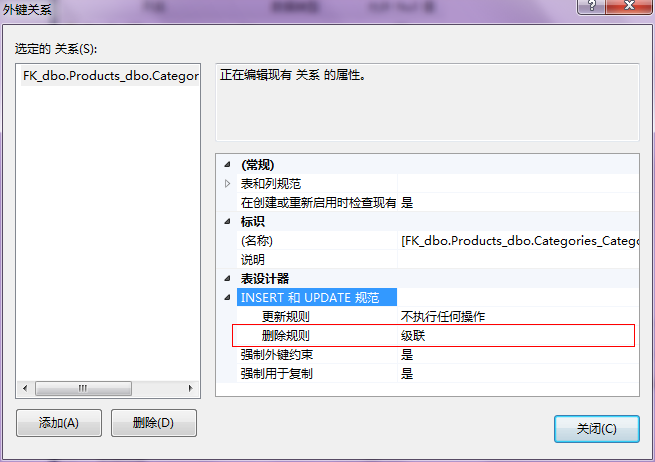
2>、[目標型別名稱]+[目標型別鍵名稱]
這種方式要求在Product表中外來鍵列名為Category類名+Category類中鍵名稱,即在Products表中生成的外來鍵名稱為Category_CategoryID。示例:在Category類中新增ICollection<Product> Products的集合屬性,而在Product類中不做任何與Category關聯的程式碼,也不定義CategoryID屬性。
檔案Category.cs:

using System; using System.Collections.Generic; using System.Linq; using System.Text; namespace Portal.Entities { public class Category { public int CategoryID { get; set; } public string CategoryName { get; set; } public virtual ICollection<Product> Products { get; set; } } }
檔案Product.cs:

using System; using System.Collections.Generic; using System.Linq; using System.Text; namespace Portal.Entities { public class Product { public int ProductID { get; set; } public string ProductName { get; set; } public decimal UnitPrice { get; set; } } }
在定義以上兩個類之後,不再新增任何的Entity Framework Code First與資料庫的對映配置,執行之後,生成的資料表結構為:
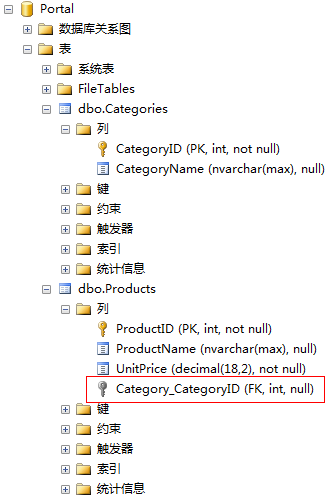
3>、[引用屬性名稱]+[目標型別鍵名稱]
這種方式為要求在Product表中外來鍵列名為在Product類中引用Category的屬性名稱 + Category類的主鍵名稱。如:在Product類中定義一個Category屬性Cat,則生成的外來鍵名稱為Cat_CategoryID。
檔案Category.cs:

using System; using System.Collections.Generic; using System.Linq; using System.Text; namespace Portal.Entities { public class Category { public int CategoryID { get; set; } public string CategoryName { get; set; } } }
檔案Product.cs:

using System; using System.Collections.Generic; using System.Linq; using System.Text; namespace Portal.Entities { public class Product { public int ProductID { get; set; } public string ProductName { get; set; } public decimal UnitPrice { get; set; } /// <summary> /// 這裡為演示,使用Cat作為Category的縮寫。 /// </summary> public virtual Category Cat { get; set; } } }
在定義以上兩個類之後,不再新增任何的Entity Framework Code First與資料庫的對映配置,執行之後,生成的資料表結構為:
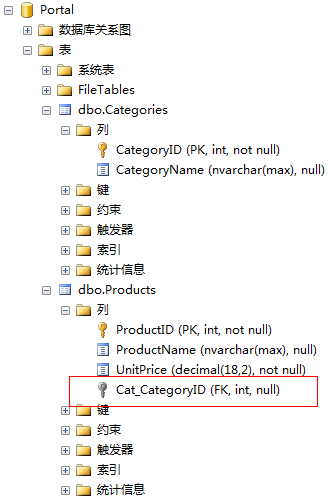
關於3種不同的外來鍵名稱命名之間存在優先順序:[目標型別的鍵名] > [引用屬性名稱]+[目標型別鍵名稱] > [目標型別名稱]+[目標型別鍵名稱]的測試方法:
[目標型別的鍵名]的最高優先順序:只要在Product類中定義了CategoryID的屬性,在Products表中生成的外來鍵列名都只會為CategoryID。
[引用屬性名稱]+[目標型別鍵名稱] > [目標型別名稱]+[目標型別鍵名稱]:只要在Product類中定義Cat屬性,不管Category類中是否定義Products屬性,生成的Products表中外來鍵都只會是Cat_CategoryID。
2、一對多關係
Entity Framework Code First在根據定義的類生成資料表時,資料表之間的外來鍵關係及所生成的外來鍵列名有預設的約定。但這種約定同樣可以進行修改,如將不滿足預設外來鍵約定的屬性來作為生成表的外來鍵。示例:Category類與Product類,在Product類中定義一個屬性CatID,要將CatID屬性作為Product的引用Category的外來鍵,而按照Entity Framework Code First的預設約定是不會的。要做到需要的CatID作為外來鍵,同樣可以使用Data Annotations和Fluent API兩種方式實現。
1>、Data Annotations方式
檔案類Category.cs:

using System; using System.Collections.Generic; using System.Linq; using System.Text; namespace Portal.Entities { public class Category { public int CategoryID { get; set; } public string CategoryName { get; set; } public virtual ICollection<Product> Products { get; set; } } }
檔案類Product.cs:

using System; using System.Collections.Generic; using System.Linq; using System.Text; using System.ComponentModel.DataAnnotations.Schema; namespace Portal.Entities { public class Product { public int ProductID { get; set; } public string ProductName { get; set; } public decimal UnitPrice { get; set; } public int CatID { get; set; } [ForeignKey("CatID")] public virtual Category Category { get; set; } } }
在定義以上兩個類之後,不再新增任何的Entity Framework Code First與資料庫的對映配置,執行之後,生成的資料表結構為:

檢視Products表的外來鍵咧CatID引用關係:

其中,在Product類中,為設定CatID屬性為外來鍵的程式碼為:
public int CatID { get; set; } [ForeignKey("CatID")] public virtual Category Category { get; set; }
該段實現方式還可以改為:
[ForeignKey("Category")] public int CatID { get; set; } public virtual Category Category { get; set; }
2>、Fluent API方式
檔案類Category.cs:

using System; using System.Collections.Generic; using System.Linq; using System.Text; namespace Portal.Entities { public class Category { public int CategoryID { get; set; } public string CategoryName { get; set; } public virtual ICollection<Product> Products { get; set; } } }
檔案類Product.cs:

using System; using System.Collections.Generic; using System.Linq; using System.Text; namespace Portal.Entities { public class Product { public int ProductID { get; set; } public string ProductName { get; set; } public decimal UnitPrice { get; set; } public int CatID { get; set; } public virtual Category Category { get; set; } } }
檔案類PortalContext.cs:

using System; using System.Collections.Generic; using System.Linq; using System.Text; using System.Data.Entity; using Portal.Entities; namespace Portal { public class PortalContext : DbContext { static PortalContext() { Database.SetInitializer(new DropCreateDatabaseIfModelChanges<PortalContext>()); } public DbSet<Category> Categories { get; set; } public DbSet<Product> Products { get; set; } protected override void OnModelCreating(DbModelBuilder modelBuilder) { modelBuilder.Entity<Category>() .HasMany(t => t.Products) .WithRequired(t => t.Category) .HasForeignKey(d => d.CatID); modelBuilder.Entity<Product>() .HasRequired(t => t.Category) .WithMany(t => t.Products) .HasForeignKey(d => d.CatID); } } }
說明:在PortalContext.cs的OnModelCreating方法中,對兩個實體類Category及Product均新增了Fluent API形式的關係配置。對於Entity Framework Code First而言,兩個實體類之間的關係,可以兩個類中均新增關係對映配置,也可以只對其中任意一個實體類新增關係對映配置。即在PortalContext.cs的OnModelCreating方法中可以只包含Category或只包含Product類的關係對映配置。這裡從Entity Framework Code First的使用經驗及技巧,建議將實體類之間關係對映配置在包含外來鍵的類中。即OnModelCreating中只新增對Product實體類的關係對映配置,這樣做有一個好處,當Category有多個表引用它時,可以將外來鍵均配置在引用它的實體類中,從而降低Category類的複雜度,同時也有益於程式碼的維護。
即在PortalContext.cs的OnModelCreating方法只需下面的定義即可:
protected override void OnModelCreating(DbModelBuilder modelBuilder) { modelBuilder.Entity<Product>() .HasRequired(t => t.Category) .WithMany(t => t.Products) .HasForeignKey(d => d.CatID); }
Entity Framework Code First根據一對多關係關係生成的外來鍵引用約束預設是有級聯刪除的,可以通過以下方式禁用Category與Product之間的級聯刪除。
protected override void OnModelCreating(DbModelBuilder modelBuilder) { modelBuilder.Entity<Product>() .HasRequired(t => t.Category) .WithMany(t => t.Products) .HasForeignKey(d => d.CatID) .WillCascadeOnDelete(false); }
也可以在Entity Framework Code First生成的全部表中都統一設定禁用一對多級聯刪除。
protected override void OnModelCreating(DbModelBuilder modelBuilder) { modelBuilder.Conventions.Remove<OneToManyCascadeDeleteConvention>(); }
雖然Entity Framework Code First是可以支援外來鍵列名自定義的,但在實際的專案中,更多的外來鍵列名稱還是與所引用表的主鍵列名相同。即在Category表中主鍵為CategoryID,在Product表中外來鍵列名稱還是為CategoryID。
Entity Framework Code First的Fluent API配置實體類與表的對映關係,還可以將所有的實體類與表的對映全部寫在一個類中,這樣可以方便程式碼的維護。
檔案類Category.cs:

using System; using System.Collections.Generic; using System.Linq; using System.Text; namespace Portal.Entities { public partial class Category { public Category() { this.Products = new List<Product>(); } public int CategoryID { get; set; } public string CategoryName { get; set; } public virtual ICollection<Product> Products { get; set; } } }
檔案類CategoryMap.cs,用於描述Category類與生成的表之間的對映關係:

using System; using System.Collections.Generic; using System.Linq; using System.Text; using System.ComponentModel.DataAnnotations.Schema; using System.Data.Entity.ModelConfiguration; using Portal.Entities; namespace Portal.Mapping { public class CategoryMap : EntityTypeConfiguration<Category> { public CategoryMap() { // Primary Key this.HasKey(t => t.CategoryID); // Properties this.Property(t => t.CategoryName) .IsRequired() .HasMaxLength(50); // Table & Column Mappings this.ToTable("Category"); this.Property(t => t.CategoryID).HasColumnName("CategoryID"); this.Property(t => t.CategoryName).HasColumnName("CategoryName"); } } }
檔案類Product.cs:

using System; using System.Collections.Generic; namespace Portal.Entities { public partial class Product { public int ProductID { get; set; } public int CategoryID { get; set; } public string ProductName { get; set; } public Nullable<decimal> UnitPrice { get; set; } public Nullable<int> Quantity { get; set; } public virtual Category Category { get; set; } } }
檔案類ProductMap.cs,用於描述Product類與生成的表之間的對映關係:

using System; using System.Collections.Generic; using System.Linq; using System.Text; using System.ComponentModel.DataAnnotations.Schema; using System.Data.Entity.ModelConfiguration; using Portal.Entities; namespace Portal.Mapping { public class ProductMap : EntityTypeConfiguration<Product> { public ProductMap() { // Primary Key this.HasKey(t => t.ProductID); // Properties this.Property(t => t.ProductName) .IsRequired() .HasMaxLength(100); // Table & Column Mappings this.ToTable("Product"); this.Property(t => t.ProductID).HasColumnName("ProductID"); this.Property(t => t.CategoryID).HasColumnName("CategoryID"); this.Property(t => t.ProductName).HasColumnName("ProductName"); this.Property(t => t.UnitPrice).HasColumnName("UnitPrice"); this.Property(t => t.Quantity).HasColumnName("Quantity"); // Relationships this.HasRequired(t => t.Category) .WithMany(t => t.Products) .HasForeignKey(d => d.CategoryID); } } }
PortalContext.cs的OnModelCreating方法:

protected override void OnModelCreating(DbModelBuilder modelBuilder) { modelBuilder.Configurations.Add(new CategoryMap()); modelBuilder.Configurations.Add(new ProductMap()); }
3、一對一關係
在一對一關係中,兩個表均有各自的主鍵,但要看哪個表的主鍵同時作為外來鍵引用另一個表的主鍵。示例以User類與UserProfile類作為兩個具有一對一關係的類,其中User類包含作為主鍵的UserID屬性,UserProfile類包含作為主鍵的ProfileID的屬性。
1>、Data Annotations方式
檔案類User.cs:

using System; using System.Collections.Generic; using System.ComponentModel.DataAnnotations; using System.ComponentModel.DataAnnotations.Schema; namespace Portal.Entities { public partial class User { [Key] public int UserID { get; set; } public string UserName { get; set; } public string Password { get; set; } public Nullable<bool> IsValid { get; set; } public virtual UserProfile UserProfile { get; set; } } }
檔案類UserProfile.cs:

using System; using System.Collections.Generic; using System.ComponentModel.DataAnnotations; using System.ComponentModel.DataAnnotations.Schema; namespace Portal.Entities { public partial class UserProfile { [Key] [ForeignKey("User")] public int ProfileID { get; set; } public string Name { get; set; } public Nullable<bool> Sex { get; set; } public Nullable<DateTime> Birthday { get; set; } public string Email { get; set; } public string Telephone { get; set; } public string Mobilephone { get; set; } public string Address { get; set; } public Nullable<DateTime> CreateDate { get; set; } public virtual User User { get; set; } } }
在定義以上兩個類之後,不再新增任何的Entity Framework Code First與資料庫的對映配置,執行之後,生成的資料表結構為:

在生成的資料表中,UserProfile表中的主鍵ProfileID同時也作為外來鍵引用User表中的主鍵UserID。
修改檔案類User.cs:

using System; using System.Collections.Generic; using System.ComponentModel.DataAnnotations; using System.ComponentModel.DataAnnotations.Schema; namespace Portal.Entities { public partial class User { [Key] [ForeignKey("UserProfile")] public int UserID { get; set; } public string UserName { get; set; } public string Password { get; set; } public Nullable<bool> IsValid { get; set; } public virtual UserProfile UserProfile { get; set; } } }
修改檔案類UserProfile.cs:

using System; using System.Collections.Generic; using System.ComponentModel.DataAnnotations; using System.ComponentModel.DataAnnotations.Schema; namespace Portal.Entities { public partial class UserProfile { [Key] public int ProfileID { get; set; } public string Name { get; set; } public Nullable<bool> Sex { get; set; } public Nullable<DateTime> Birthday { get; set; } public string Email { get; set; } public string Telephone { get; set; } public string Mobilephone { get; set; } public string Address { get; set; } public Nullable<DateTime> CreateDate { get; set; } public virtual User User { get; set; } } }
則實體類執行之後生成的資料表User主鍵UserID將同時作為外來鍵引用UserProfile表的主鍵ProfileID。
2>、Fluent API方式
Fluent API設定實體類生成的表引用與被引用通過WithRequiredPrincipal、WithRequiredDependent及WithOptionalPrincipal、WithOptionalDependent來設定,使用Principal屬性的實體類將被另外的實體類生成的表引用,使用Dependent屬性的實體類將引用另外的實體類。
檔案類User.cs:

using System; using System.Collections.Generic; using System.ComponentModel.DataAnnotations; using System.ComponentModel.DataAnnotations.Schema; namespace Portal.Entities { public partial class User { public int UserID { get; set; } public string UserName { get; set; } public string Password { get; set; } public Nullable<bool> IsValid { get; set; } public virtual UserProfile UserProfile { get; set; } } }
對映檔案類UserMap.cs:

using System; using System.Collections.Generic; using System.Linq; using System.Text; using System.ComponentModel.DataAnnotations.Schema; using System.Data.Entity.ModelConfiguration; using Portal.Entities; namespace Portal.Mapping { public class UserMap : EntityTypeConfiguration<User> { public UserMap() { // Primary Key this.HasKey(t => t.UserID); // Properties this.Property(t => t.UserName) .HasMaxLength(50); this.Property(t => t.Password) .HasMaxLength(100); // Table & Column Mappings this.ToTable("User"); this.Property(t => t.UserID).HasColumnName("UserID"); this.Property(t => t.UserName).HasColumnName("UserName"); this.Property(t => t.Password).HasColumnName("Password"); this.Property(t => t.IsValid).HasColumnName("IsValid"); } } }
檔案類UserProfile.cs:

using System; using System.Collections.Generic; namespace Portal.Entities { public partial class UserProfile { public int UserID { get; set; } public string Name { get; set; } public Nullable<bool> Sex { get; set; } public Nullable<DateTime> Birthday { get; set; } public string Email { get; set; } public string Telephone { get; set; } public string Mobilephone { get; set; } public string Address { get; set; } public Nullable<DateTime> CreateDate { get; set; } public virtual User User { get; set; } } }
對映檔案類UserProfileMap.cs:

using System; using System.Collections.Generic; using System.Linq; using System.Text; using System.ComponentModel.DataAnnotations.Schema; using System.Data.Entity.ModelConfiguration; using Portal.Entities; namespace Portal.Mapping { public class UserProfileMap : EntityTypeConfiguration<UserProfile> { public UserProfileMap() { // Primary Key this.HasKey(t => t.UserID); // Properties this.Property(t => t.UserID) .HasDatabaseGeneratedOption(DatabaseGeneratedOption.None); this.Property(t => t.Name) .IsRequired() .HasMaxLength(50); this.Property(t => t.Email) .IsRequired() .HasMaxLength(100); this.Property(t => t.Telephone) .HasMaxLength(50); this.Property(t => t.Mobilephone) .HasMaxLength(20); this.Property(t => t.Address) .HasMaxLength(200); // Table & Column Mappings this.ToTable("UserProfile"); this.Property(t => t.UserID).HasColumnName("UserID"); this.Property(t => t.Name).HasColumnName("Name"); this.Property(t => t.Sex).HasColumnName("Sex"); this.Property(t => t.Birthday).HasColumnName("Birthday"); this.Property(t => t.Email).HasColumnName("Email"); this.Property(t => t.Telephone).HasColumnName("Telephone"); this.Property(t => t.Mobilephone).HasColumnName("Mobilephone"); this.Property(t => t.Address).HasColumnName("Address"); this.Property(t => t.CreateDate).HasColumnName("CreateDate"); // Relationships this.HasRequired(t => t.User) .WithRequiredDependent(t => t.UserProfile); } } }
在以上實體類及實體對映類執行以後,生成的資料表結構如下:
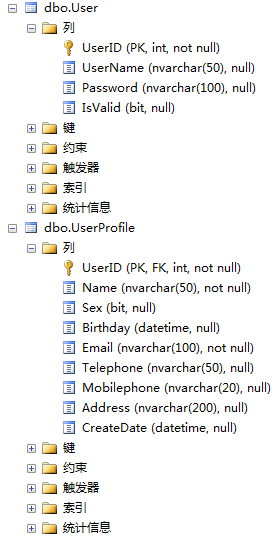
在生成的表結構中,UserProfile表中的主鍵UserID同時也作為外來鍵引用User表的主鍵UserID。若修改UserProfileMap.cs如下,則生成的表結構User表的主鍵UserID將作為你外來鍵引用UserProfile表的主鍵UserID。

using System; using System.Collections.Generic; using System.Linq; using System.Text; using System.ComponentModel.DataAnnotations.Schema; using System.Data.Entity.ModelConfiguration; using Portal.Entities; namespace Portal.Mapping { public class UserProfileMap : EntityTypeConfiguration<UserProfile> { public UserProfileMap() { // Primary Key this.HasKey(t => t.UserID); // Properties this.Property(t => t.UserID) .HasDatabaseGeneratedOption(DatabaseGeneratedOption.None); this.Property(t => t.Name) .IsRequired() .HasMaxLength(50); this.Property(t => t.Email) .IsRequired() .HasMaxLength(100); this.Property(t => t.Telephone) .HasMaxLength(50); this.Property(t => t.Mobilephone) .HasMaxLength(20); this.Property(t => t.Address) .HasMaxLength(200); // Table & Column Mappings this.ToTable("UserProfile"); this.Property(t => t.UserID).HasColumnName("UserID"); this.Property(t => t.Name).HasColumnName("Name"); this.Property(t => t.Sex).HasColumnName("Sex"); this.Property(t => t.Birthday).HasColumnName("Birthday"); this.Property(t => t.Email).HasColumnName("Email"); this.Property(t => t.Telephone).HasColumnName("Telephone"); this.Property(t => t.Mobilephone).HasColumnName("Mobilephone"); this.Property(t => t.Address).HasColumnName("Address"); this.Property(t => t.CreateDate).HasColumnName("CreateDate"); // Relationships this.HasRequired(t => t.User) .WithRequiredPrincipal(t => t.UserProfile); } } }
4、多對多關係
Entity Framework Code First在根據定義的多對多關係的類生成資料表時,除了生成實體類定義的屬性表之外,還會生成一箇中間表。用於體現兩個實體表之間的多對多的關係。示例實體類User與Role為多對多關係,一個使用者可以屬於多個角色,一個角色可以包含多個使用者。
檔案類User.cs:

using System; using System.Collections.Generic; namespace Portal.Entities { public partial class User { public int UserID { get; set; } public string UserName { get; set; } public string Password { get; set; } public Nullable<bool> IsValid { get; set; } public virtual ICollection<Role> Roles { get; set; } } }
檔案類Role.cs:

using System; using System.Collections.Generic; namespace Portal.Entities { public partial class Role { public Role() { this.Users = new List<User>(); } public int RoleID { get; set; } public string RoleName { get; set; } public virtual ICollection<User> Users { get; set; } } }
在定義以上兩個類之後,不再新增任何的Entity Framework Code First與資料庫的對映配置,執行之後,生成的資料表結構為:

從以上的表結構中,可以看出,實體類執行之後,除了生成Users表和Roles表之外,還生成了RoleUsers表作為中介表,體現Users表和Roles表之間的多對多關聯關係。中介表RoleUsers的欄位生成規則按照 [目標型別名稱]+[目標型別鍵名稱] 的約定。
Entity Framework Code First根據預設約定生成的多對多關聯關係的表時,預設啟用多對多的資料級聯刪除,可以新增程式碼進行禁用。
protected override void OnModelCreating(DbModelBuilder modelBuilder) { // 禁用多對多關係表的級聯刪除 modelBuilder.Conventions.Remove<ManyToManyCascadeDeleteConvention>(); }
FluentAPI實現方式:
檔案類User.cs:

using System; using System.Collections.Generic; namespace Portal.Entities { public partial class User { public int UserID { get; set; } public string UserName { get; set; } public string Password { get; set; } public Nullable<bool> IsValid { get; set; } public virtual ICollection<Role> Roles { get; set; } } }
對映檔案類UserMap.cs:

using System.ComponentModel.DataAnnotations.Schema; using System.Data.Entity.ModelConfiguration; using Portal.Entities; namespace Portal.Mapping { public class UserMap : EntityTypeConfiguration<User> { public UserMap() { // Primary Key this.HasKey(t => t.UserID); // Properties this.Property(t => t.UserName) .HasMaxLength(50); this.Property(t => t.Password) .HasMaxLength(100); // Table & Column Mappings this.ToTable("User"); this.Property(t => t.UserID).HasColumnName("UserID"); this.Property(t => t.UserName).HasColumnName("UserName"); this.Property(t => t.Password).HasColumnName("Password"); this.Property(t => t.IsValid).HasColumnName("IsValid"); } } }
檔案類Role.cs:

using System; using System.Collections.Generic; namespace Portal.Entities { public partial class Role { public int RoleID { get; set; } public string RoleName { get; set; } public virtual ICollection<User> Users { get; set; } } }
對映檔案類RoleMap.cs:

using System.ComponentModel.DataAnnotations.Schema; using System.Data.Entity.ModelConfiguration; using Portal.Entities; namespace Portal.Mapping { public class RoleMap : EntityTypeConfiguration<Role> { public RoleMap() { // Primary Key this.HasKey(t => t.RoleID); // Properties this.Property(t => t.RoleName) .HasMaxLength(50); // Table & Column Mappings this.ToTable("Role"); this.Property(t => t.RoleID).HasColumnName("RoleID"); this.Property(t => t.RoleName).HasColumnName("RoleName"); // Relationships this.HasMany(t => t.Users) .WithMany(t => t.Roles) .Map(m => { m.ToTable("UserRole"); m.MapLeftKey("RoleID"); m.MapRightKey("UserID"); }); } } }
執行之後生成的表結構:
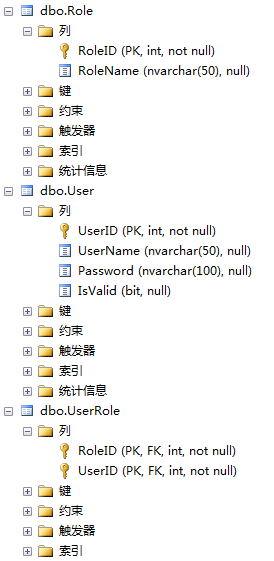
5、一對多自反關係
一對多自反關係,即一個表存在一個外來鍵列引用自身的主鍵。在專案中,最常見的一對多自反關係為分類表,分類表通過一個ParentID列儲存引用主鍵,已實現無限級遞迴。
Fluent API實現方式:
檔案類Category.cs:

using System; using System.Collections.Generic; namespace Portal.Entities { public class Category { public int CategoryID { get; set; } public int CategoryNo { get; set; } public string CategoryName { get; set; } public Nullable<int> ParentID { get; set; } public virtual Category Parent { get; set; } public virtual ICollection<Category> Children { get; set; } } }
對映檔案類CategoryMap.cs:

using System.ComponentModel.DataAnnotations.Schema; using System.Data.Entity.ModelConfiguration; using Portal.Entities; namespace Portal.Mapping { public class CategoryMap : EntityTypeConfiguration<Category> { public CategoryMap() { // Primary Key this.HasKey(t => t.CategoryID); // Properties this.Property(t => t.CategoryName) .IsRequired() .HasMaxLength(50); // Table & Column Mappings this.ToTable("Category"); this.Property(t => t.CategoryID).HasColumnName("CategoryID"); this.Property(t => t.CategoryNo).HasColumnName("CategoryNo"); this.Property(t => t.CategoryName).HasColumnName("CategoryName"); this.Property(t => t.ParentID).HasColumnName("ParentID"); // Relationships this.HasOptional(t => t.Parent) .WithMany(t => t.Children) .HasForeignKey(d => d.ParentID); } } }
以上程式碼在執行之後,生成的資料表:
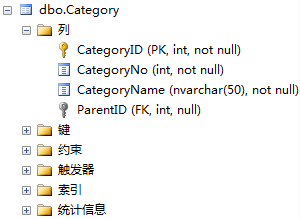
6、多對多自反關係
多對多關係示例:Family中一條記錄可能有多個Parents,也可能有多個Children。
檔案類Family.cs:

using System; using System.Collections.Generic; namespace Portal.Entities { /// <summary> /// Family表多對多自反關係 /// </summary> public partial class Family { public Family() { this.Parents = new List<Family>(); this.Children = new List<Family>(); } public int FamilyID { get; set; } public string Name { get; set; } public Nullable<bool> Sex { get; set; } public Nullable<System.DateTime> Birthday { get; set; } public virtual ICollection<Family> Parents { get; set; } public virtual ICollection<Family> Children { get; set; } } }
對映檔案類FamilyMap.cs:

using System.ComponentModel.DataAnnotations.Schema; using System.Data.Entity.ModelConfiguration; using Portal.Entities; namespace Portal.Mapping { public class FamilyMap : EntityTypeConfiguration<Family> { public FamilyMap() { // Primary Key this.HasKey(t => t.FamilyID); // Properties this.Property(t => t.Name) .HasMaxLength(50); // Table & Column Mappings this.ToTable("Family"); this.Property(t => t.FamilyID).HasColumnName("FamilyID"); this.Property(t => t.Name).HasColumnName("Name"); this.Property(t => t.Sex).HasColumnName("Sex"); this.Property(t => t.Birthday).HasColumnName("Birthday"); // Relationships this.HasMany(t => t.Parents) .WithMany(t => t.Children) .Map(m => { m.ToTable("FamilyRelationship"); m.MapLeftKey("ParentID"); m.MapRightKey("ChildID"); }); } } }
Family類及對映配置類,在執行之後生成的資料表結構:
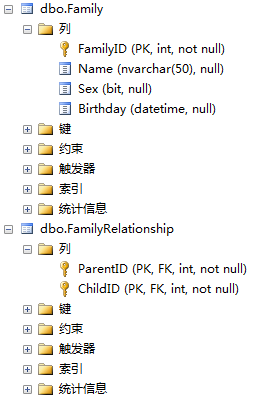
在上面的表結構中,指定Family之間的中介表為FamilyRelationship,其中FamilyRelationship的兩個欄位ParentID及ChildID均引用Familyi表中的FamilyID作為外來鍵。可能在實際的專案過程中,出現這種多對多自反引用關係的情況比較少見。
